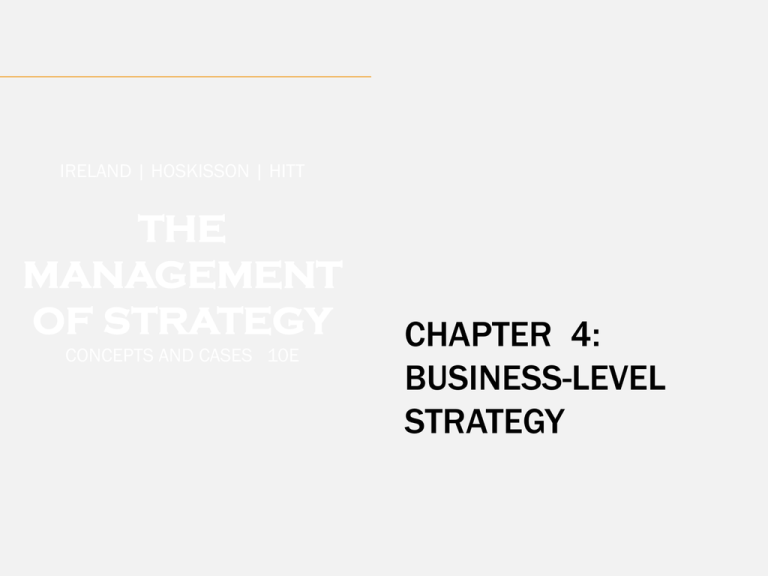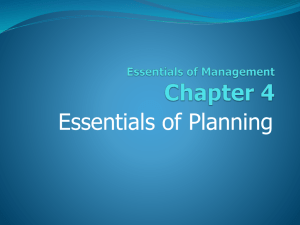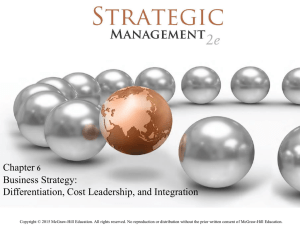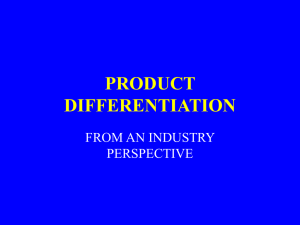
IRELAND | HOSKISSON | HITT
THE
MANAGEMENT
OF STRATEGY
CONCEPTS AND CASES 10E
CHAPTER 4:
BUSINESS-LEVEL
STRATEGY
THE STRATEGIC MANAGEMENT
PROCESS
KNOWLEDGE OBJECTIVES
● Define business-level strategy.
● Discuss the relationship between
customers and business-level strategies in
terms of who, what, and how.
● Explain the differences among businesslevel strategies.
● Use the five forces of competition model to
explain how above-average returns can be
earned through each business-level strategy.
● Describe the risks of using each of the
business-level strategies.
IMPORTANT DEFINITION
BUSINESS–LEVEL STRATEGY: HOW
TO COMPETE IN A SPECIFIC INDUSTRY
■ An integrated and coordinated set of
commitments and actions the firm uses to gain
a competitive advantage by exploiting core
competencies in specific product markets
■ It is the core strategy
■ Every firm must form and use a business-level
strategy for each one of its businesses
■ Business-level strategy choices matter because
long-term performance is linked to a firm’s
strategies
BUSINESS-LEVEL STRATEGY
ONE
BUSINESSLEVEL
STRATEGY
SEVERAL
BUSINESSLEVEL
STRATEGIES
•A single-product market/single
geographic location firm employs
one business-level strategy and
one corporate-level strategy
identifying what or which industry
the firm will compete in
•A diversified firm employs a
separate business-level strategy
for each product market area in
which it competes and one or
more corporate-level strategies
dealing with product and/or
geographic diversity
CORE COMPETENCIES AND
STRATEGY
Core
Competencies
Strategy
Business-level
Strategy
Resources and superior capabilities that
are sources of competitive advantage
over a firm’s rivals
An integrated and coordinated set of
actions taken to exploit core competencies
and gain competitive advantage
Providing value to customers and gaining
competitive advantage by exploiting core
competencies in individual product
markets
CUSTOMERS: THEIR RELATIONSHIP
TO BUSINESS-LEVEL STRATEGIES
Who will be
served?
KEY ISSUES
in
BUSINESSLEVEL
STRATEGY
What needs will
be satisfied?
How will those
needs be satisfied?
CUSTOMERS: THEIR RELATIONSHIP
TO BUSINESS-LEVEL STRATEGIES
EFFECTIVE
GLOBAL
COMPETITORS
Adept at identifying
customer needs across
cultures and geography
Quickly and successfully
adapt products/services
to meet those needs
BUSINESS-LEVEL STRATEGIES
FIVE COMPETITIVE FORCES
GENERIC:
Applicable
to any
organization in
any
industry
VALUE CHAIN
ACTIVITIES
RISKS for each Strategy
Effective STRUCTURE
for each Strategy
CUSTOMERS: THEIR RELATIONSHIP
TO BUSINESS-LEVEL STRATEGIES
SATISFYING CUSTOMERS IS THE
FOUNDATION OF SUCCESSFUL
BUSINESS STRATEGIES
• Managing relationships with customers
• Reach, richness, affiliation
• Who will be served
• What needs will be satisfied
• How those needs will be satisfied
CUSTOMERS: THEIR RELATIONSHIP
TO BUSINESS-LEVEL STRATEGIES
REACH
EFFECTIVELY
MANAGING
RELATIONSHIPS
WITH
CUSTOMERS
Access and Connection
to Customers
RICHNESS
Depth and Detail of Two-Way Flow
of Information Between
the Firm and Customer
AFFILIATION
Facilitating Useful Interactions
With Customers
WHO: DETERMINING THE
CUSTOMERS TO SERVE
MARKET SEGMENTATION
A PROCESS USED TO CLUSTER PEOPLE
WITH SIMILAR NEEDS INTO INDIVIDUAL
AND IDENTIFIABLE GROUPS
Consumer
Markets
Industrial
Markets
MARKET SEGMENTATION:
CONSUMER MARKETS
1. DEMOGRAPHIC FACTORS
(age, income, sex, etc.)
2. SOCIOECONOMIC FACTORS
(social class, stage in the family life cycle)
3. GEOGRAPHIC FACTORS
(cultural, regional, and national differences)
4. PSYCHOLOGICAL FACTORS
(lifestyle, personality traits)
5. CONSUMPTION PATTERNS
(heavy, moderate, and light users)
6. PERCEPTUAL FACTORS
(benefit segmentation, perceptual mapping)
WHAT: DETERMINING WHICH
CUSTOMER NEEDS TO SATISFY
■ Customer needs are related to a
product’s benefits and features
■ Customer needs are neither right nor
wrong, good nor bad
■ Customer needs represent desires in
terms of features and performance
capabilities
■ Successful firms learn how to deliver to
customers what they want, when they want
it
Customers are the lifeblood of a firm
CUSTOMERS:
HOW ● WHAT ● WHO
WHAT:
Satisfy Customer
Needs
WHO:
Target Group
of Customers
BUSINESS-LEVEL STRATEGY
PURPOSE
BUSINESS-LEVEL STRATEGIES
are intended to create differences
between the firm’s position relative to
those of its rivals
To position itself, the firm must decide
whether it intends to:
● Perform activities differently, or
● Perform different activities as
compared to its rivals
BUSINESS-LEVEL STRATEGY
PURPOSE
BUSINESS-LEVEL STRATEGY
is a deliberate choice about how the firm will
perform the value chain activities to create
unique value
Southwest’s Competitive Advantages (rivals
unable to imitate):
● Tight integration among activities
● Cost leadership strategy
● Unique culture and customer service
BUSINESS-LEVEL STRATEGY
PURPOSE
Southwest
Airlines Activity
System
SOURCES OF COMPETITIVE
ADVANTAGE
■ Achieving LOWER OVERALL COSTS than rivals
■ Performing activities differently (reducing process
costs)
■ Providing a low cost product that customers deem as
ACCEPTABLE
■ Possessing the capability TO DIFFERENTIATE the
firm’s product or service and command a premium
price
■ Performing MORE HIGHLY VALUED activities
FIVE GENERIC BUSINESS-LEVEL
STRATEGIES
Five Business
Level
Strategies
TARGET MARKETS
BROAD
NARROW
•Firms serving a broad market seek
to use their capabilities to create
value for customers on an
industry-wide basis; competing in
many customer segments
•A narrow market segment means
that the firm intends to serve the
needs of a narrow customer
group; tailoring its strategy to
serving them at the exclusion of
others
BUSINESS-LEVEL STRATEGY
EFFECTIVENESS
■ None of the five business-level strategies is
inherently or universally superior to the others
■ The effectiveness of each strategy is contingent
upon:
● External opportunities/threats
● Internal strengths/weaknesses
■ KEY: A successful business-level strategy must
match external opportunities/threats with internal
strengths, i.e., its core competencies
COST LEADERSHIP STRATEGY
An integrated set of actions taken to
produce goods or services with features
that are acceptable to customers at the
lowest cost, relative to that of
competitors with features that are
acceptable to customers
■ Relatively standardized products
■ Features acceptable to many customers
■ Lowest competitive price
COST LEADERSHIP STRATEGY:
VALUE CHAIN ACTIVITIES
■ Value chain analysis identifies the parts of a
firm’s operations that create value and those
that do not
■ A competitive advantage in logistics creates
more value for a cost leadership strategy than
for a differentiation strategy
Inbound logistics [materials handling,
warehousing, and inventory control]
Outbound logistics [collecting, storing, and
distribution]
COST LEADERSHIP STRATEGY:
VALUE CHAIN ACTIVITIES
Examples of
Value-Creating
Activities
Associated
with the CostLeadership
Strategy
VALUE-CREATING ACTIVITIES FOR
COST LEADERSHIP
RECONFIGURE THE VALUE CHAIN FOR COST ADVANTAGE
•
Cost-effective MIS
•
Monitor suppliers’ performances
•
Few management layers
•
•
Simplified planning
Link suppliers’ products to
production processes
•
Consistent policies
•
Economies of scale
•
Effecting training
•
Efficient-scale facilities
•
Easy-to-use manufacturing
technologies
•
Effective delivery schedules
•
Investments in technologies
•
Low-cost transportation
•
Finding low cost raw materials
•
Highly trained sales force
•
Proper pricing
VALUE-CREATING ACTIVITIES FOR
COST LEADERSHIP
Alter production process
New raw material
Change in automation
Forward integration
New distribution channel
Backward integration
Change location relative to
suppliers or buyers
New advertising media
Direct sales in place of
indirect sales
COST LEADERSHIP STRATEGY:
RISKS
• COMPETITIVE RISKS
– OBSOLESCENCE: processes used to produce
and distribute goods/services may become
obsolete due to competitors’ innovations
– COST REDUCTIONS: too much focus on cost
reductions may occur at expense of customers’
perceptions of differentiation
– IMITATION: competitors, using their own core
competencies, may successfully imitate the cost
leader’s strategy
DIFFERENTIATION STRATEGY
An integrated set of actions taken to
produce goods or services (at an
acceptable cost) that customers perceive
as being different in ways that are
important to them
■ Focus is on non-standardized products
■ Appropriate when customers value
differentiated features more than they value
low cost
■ Firms must still be able to produce
differentiated products at competitive costs
to reduce upward pressure on the price that
customers pay
DIFFERENTIATION STRATEGY:
DISTINCTIVE ACTIONS
Firms seek to be different from competitors on as
many dimensions as possible
Differentiation approaches
■ Unusual features
■ Responsive customer service
■ Rapid product innovations
■ Technological leadership
■ Perceived prestige and status
■ Different tastes
■ Engineering design and performance
DIFFERENTIATION STRATEGY:
VALUE CHAIN ACTIVITIES
Examples of
Value-Creating
Activities
Associated
with the
Differentiation
Strategy
VALUE-CREATING ACTIVITIES FOR
DIFFERENTIATION
•
Highly developed MIS
•
High quality replacement parts
•
Emphasis on quality
•
•
Worker compensation for
creativity/productivity
Superior handling of incoming
raw materials
•
Attractive products
•
Use of subjective
performance measures
•
Rapid response to customer
specifications
•
Basic research capability
•
Order-processing procedures
•
Technology
•
Customer credit
•
High quality raw materials
•
Personal relationships
•
Delivery of products
VALUE-CREATING ACTIVITIES FOR
DIFFERENTIATION
RECONFIGURE THE VALUE CHAIN FOR DISTINCTIVENESS
Whereas cost leadership targets a specific industry,
differentiation creates value by distinguishing
products/services
A firm must consistently upgrade differentiated features
that customers value and/or create new valuable features
(innovate) without significant cost increases
Create sustainability through:
Customer perceptions of distinctiveness
Customer reluctance to switch to non-distinctive
products
DIFFERENTIATION STRATEGY:
RISKS
• COMPETITIVE RISKS
– PRICE DIFFERENTIAL: between the differentiator’s and the
cost leader’s products becomes too large
– VALUE DIMINISHED: Differentiation ceases to provide
value for which customers are willing to pay
– EXPERIENCE: narrows customers’ perceptions of the value
of differentiated features
– COUNTERFEIT: goods replicate differentiated features of
the firm’s products
FOCUSED STRATEGIES
An integrated set of actions taken to produce
goods or services that serve the needs of a
particular competitive segment
Target markets include:
■ Particular buyer group (e.g., youths or senior
citizens)
a
■ Different segment of a product line (e.g.,
products for professional painters or the do-ityourself group)
■ Different geographic market (e.g., northern or
southern Italy by using a foreign subsidiary)
FOCUSED STRATEGIES
Types of focused strategies:
■ Focused cost leadership strategy
■ Focused differentiation strategy
To implement a focus strategy,
firms must be able to:
Complete various value chain activities in a
competitively superior manner in order to
develop and sustain a competitive advantage
and earn above-average returns
FACTORS THAT DRIVE
FOCUSED STRATEGIES
■ Large firms may overlook small niches
■ A firm may lack the resources needed to
compete in the broader market
■ A firm is able to serve a narrow market
segment more effectively than its larger
industry-wide competitors can
■ Focusing allows the firm to direct its
resources to certain value chain activities
to build competitive advantage
FOCUSED COST LEADERSHIP
STRATEGY
A firm focuses on a niche market,
adding value by leveraging value
chain activities that allow valuecreation through the cost
leadership strategy
■ Competitive advantage: low-cost
■ Competitive scope: narrow industry
segment
FOCUSED DIFFERENTIATION
STRATEGY
The value chain may be analyzed to
determine if a firm is able to link the
activities required to create value by
using the focused differentiation
strategy
■ Competitive advantage: differentiation
■ Competitive scope: narrow industry
segment
FOCUS STRATEGIES: RISKS
• COMPETITIVE RISKS
– OUTFOCUSED: a focusing firm may be
“outfocused” by its competitors
– COMPETITION: a large competitor may
decide that the market segment served by
the focus strategy firm is attractive and
worthy of competitive pursuit
– CHANGING PREFERENCES: customer
preferences in the niche market may
change to more closely resemble those of
the broader market
INTEGRATED COST LEADERSHIP/
DIFFERENTIATION STRATEGY
Efficiently produce products with differentiated attributes:
• EFFICIENCY: SOURCES OF LOW COST
• DIFFERENTIATION: SOURCE OF UNIQUE VALUE
■ Readily adapts to external environmental changes
■ Concentrates simultaneously on TWO sources of
competitive advantage: cost and differentiation
■ Competence and flexibility required in several value chain
activities
INTEGRATED COST LEADERSHIP/
DIFFERENTIATION STRATEGY
Three sources of flexibility useful
for this strategy:
■ Flexible manufacturing systems (FMS)
■ Information networks
■ Total quality management (TQM) systems
INFORMATION NETWORKS
Links companies electronically with their
suppliers, distributors, and customers
■ Facilitates efforts to satisfy customer expectations
in terms of product quality and delivery speed
■ Improves flow of work among employees in the
firm and their counterpart suppliers and distributors
■ Requires customer relationship management
(CRM)









